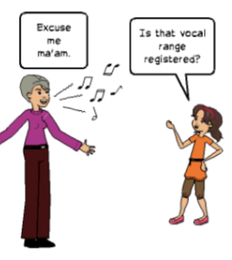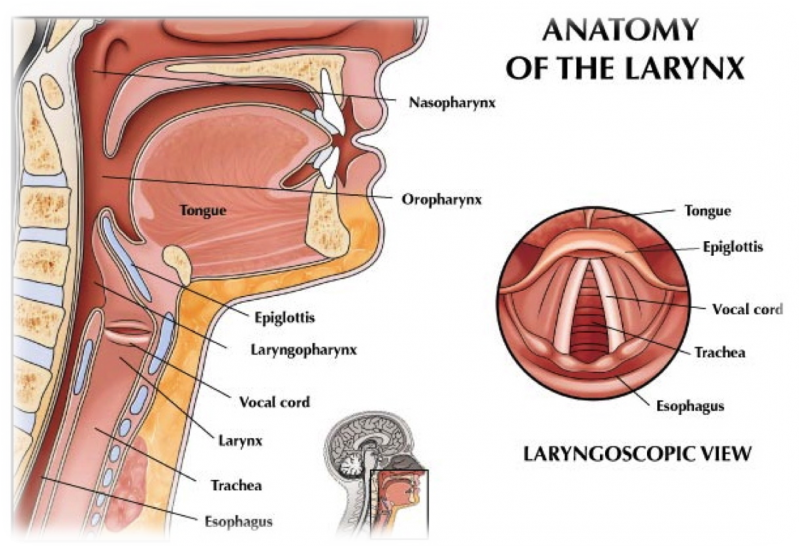 I have spent the majority of my professional music career in church music. When I began as a young teenager, I found that I had a hard time singing above certain pitches. My teenage self regarded these “certain pitches” as my “normal” voice. Everything above that area was deemed different and separate. I could also phonate below my “normal voice”, but that was quite low and only used to be funny or to imitate my father. Thus I stumbled into the marvelous and confusing world of registers. Now many people have written at length, on what is and is not a register. I do not wish to participate in the larger scientific and pedagogic discussion overall on defining registers. This blog is merely to reassure the beginning singer and speaker of what may be happening to their voice, or maybe to inform the non-novice of perhaps a better and clearer way to speak of a real physiological process. However, I still have to propose what I believe is the correct definition of a register. A register is a group of tones that a speaker and/or singer produces which share the following: similar sound qualities, as well as similar methods of producing the tones. An example is if I asked you to pretend you were the character of “Lurch” in the Addams Family. You would produce tones that might be classified by some as Vocal Fry by the sound. At the same time, if we were to see your vocal folds, as well as measure the air coming through them as you produced the sound, we would see them behaving in a manner that is fairly relaxed, but with a lowered quantity of air (Johns Hopkins). This method of phonating (vocalizing) has been likened to perhaps strumming a very loose guitar string. (Brainstuff).
 ,, What my teenage self imagined as my “normal voice” was the pattern which is often described as “modal voice”. This is nicely visualized in this graphic from Wikipedia. It is the type of phonation where the muscles of the vocal fold vibrate while opening and closing. It is a cycle which begins in the lower portion of the fold and then followed by the upper portion. It is the default speaking mode of most people and thus regarded by many as the “normal voice.” Now remember there have to be two components to speaking of register—the tone as well, as the method of the voice production. If you are just speaking of a tone…and not a change in the movement pattern of the vocal folds, I suggest you use the term resonance. We will get to resonance another time. When I began voice lessons, I thought I had a flawed voice because, it suddenly got “strange” to this Ann Wilson, Robert Plant, wanna-bee. With guidance I learned fairly quickly to start working out those areas and quickly discovered my upper range, which was comprised of a falsetto register (or a head register) and eventually a whistle register. Unbeknownst to me I was training my muscles to make smooth adjustments while transitioning between my modal range and the falsetto range. Just like two dancers, two pairs of muscles had to balance each other out as the pitch went up or down.
Shifting registers is a motor learning process, not that much different from learning how to dance, to play the piano, to skip, or, to eat using chopsticks. The more often I worked on shifting my registers, the more comfortable I became with those transitions, until, well until it was like walking. So to the novice singer who is frightened or uncomfortable with those transitions, I say, “fear not.” Remember you didn’t learn how to read instantaneously, or eat neatly without practicing everyday. Working your registers correctly will need the same practice! Don't be afraid to ask for help from an instructor when you need it!
1. http://www.ncvs.org/pas/2004/pres/thurman/ThurmanPaper.html
0 Comments
When I started this blog, it was to share information with you: the voice user, whether you are a singer, actor, comedian, teacher, lawyer, or doctor. I also intend to address those who were trained in the use of the voice, but who may not have had background in vocal pedagogy. Of course I am also addressing the vocal pedagogist, who may not have had a background in vocal science, or who may have had it at one time, but hasn’t kept up with the latest work of the past thirty years. Maybe you are a Speech Language Pathologist who doesn’t usually work with voice and is looking for a simpler explanation of things before jumping off into more technical explanations. If any of these categories apply to you, this blog is for you.
I will usually give you evidence based information not speculations. It is not intended to diagnose or provide treatment, or training. I will let you know if there is information available on a particular subject or usage that occurs to me. At times I will actually post what is my opinion. This will hopefully be an opinion based on some evidence, but that is mostly based on my experience as a teacher and voice therapist. This experience may be different from the average teacher of singing or vocologist for several reasons. 1) We all have some bias. Yes indeed! Here is a simple test to measure whether a scientist, reporter, or average Joe has a bias—check to see if they have a pulse. If the pulse is there ,so is a bias. Hopefully it will be recognized by that individual stating the information, unfortunately it isn’t always. 2) Most vocalists of any stripe, be they a singer, an actor, a teacher, an orator, or a customer service representative, is most familiar with their own experience. This will color how data is translated to that person. Sometimes it makes total sense to that person, for example: Mount Everest is not the tallest mountain in the world—Mauna Kea is. When you measure it from the base of the mountain Mauna Kea is over 32,000 fee. Mount Everest starts pretty high up already, so measuring from the base, it is somewhere between 11,980 and 15,260 feet. This makes sense to me. I have known friends and relatives claim that this is “cheating.” Sometimes data do not jibe with our experience. For example, sugar has been disproved to activate ADHD in children, however, that never stopped me from believing that I get “hyper” after a large dosage of sugar. Of course I argue, I am not a child. I do recognize this is an unfounded claim. Sometimes our experience does belie an overall trend, simply because despite DNA that is 99.9 percent identical from human to human, there is a wide range of a “typical” human being. So sometimes there are outliers to trends. A personal example is that my feet are significantly smaller than would be expected of a woman my height. If I had taken my own experience of shoe size versus height as the rule, most of the folks around me have strangely large feet. The truth is, I don’t fit into the rule of feet size and height, and I have strangely small feet. My studies have helped to detach myself from using my own experience as the rule. However, since I have a pulse, I do not claim to be perfect. 3) Where one practices your profession can color your perception of reality. I have had the good fortune to live and work on three “continents” if you count Oceania (the large collection of islands scattered throughout the Pacific.) Each place has provided distinct populations with different demands. It is easy to get caught up within that population and assume that what happens in that area, is what happens everywhere. Here in Hawaii, the influence of Hawaiian Pidgin can make many speakers use a falling intonation in questions. Standard American English questions use a rising intonation. I have actually witnessed traveling speech language pathologists try to “fix” this problem in a child under their care, since within the SLP’s experience, it is a problem. So, I hope this explains the purpose of this blog as well as the expectations you should have on this blog. I encourage questions and would love to know where your interest lies. There is no question too silly, or too obvious to ask. I will let you know if I know, or where you might turn to get the answer, or whether anyone has an answer. Comments are also encouraged. Since it is my blog, I hold the right to moderate and insist that comments be respectful to all peoples, including humans. I sign off with these words: keep hydrated through the heat, breathe deep, and remember to vocalize easily and with a vibration in your head! ,This is HAWAII Voice and Speech Studio so, here is information that might help the voice user get through the rough summer days when Kona winds blow.
On January 3rd, 1983 history was made when a vent, stemming from Hawaii’s second youngest volcano, (Kilauea) began erupting. It has continued erupting more or less ever since, sometimes dramatically, sometimes without nary a visible trace but for steam vents. It is to date, the longest volcanic eruption in written history. Thus began Hawai’i's modern experience with vog. Vog, like smog, is a made up word. Smoke + fog became the word smog and volcano + smog became the word vog. According to Wikipedia “vog is a form of air pollution that results when sulfur dioxide, other gasses, and particles, emitted by an erupting volcano, react with oxygen and moisture in the presence of sunlight”. Smog on the other hand is formed when combustion of some kind (the burning of a substance) “…interacts with nitrogen oxide and ozone. Smog can be derived from coal emissions, vehicular emissions, industrial emissions, forest and agricultural fires…”(Wikipedia.org). Vog is similar to smog, in that it is formed when an emitted chemical reacts with another substance to create an aerosol (or a mixture of fine solid particles or liquid droplets in air, like hairspray). The aerosol then makes the pollution visible. However, smog and vog are not the same. The chemicals produced are usually different. Vog contains hydrogen sulfide, hydrogen chloride, and hydrogen fluoride. The emphasis is on the hydrogen since it must bond with moisture (water) in the air. (https://hilo.hawaii.edu/~nat_haz/vog/). Ash might also be present, particularly in areas closer to the source (Hilo, Volcano Village, Ke’eau etc.) Since 1997 the output of sulfur dioxide has been measured, and at times as much as 2500 metrtic tonnes are produced in a single day. Luckily for most of the population of the Hawaiian Islands, the trade winds, which blow from the North-Northeast, push most of this pollution out to sea where it dissipates. However, there are the days when the Kona winds (warm tropical winds blowing from the south towards the northeast) transport the pollution as far as O’ahu where 900,000 people live. Vog can be a problem for many. While it is difficult to study the long term effects, due to the highly dangerous nature of some of the substances, there are easily identified short term effects. These are particularly evident in those with breathing difficulties such as asthma or other reactive airway diseases. Here is a list of symptoms and practical ways to mitigate these symptoms:
What can you do about vog particularly as a vocalist? If you are experiencing some of these symptoms, consider the following steps to mitigate vocal and other problems:
Summer is always a great time in Hawai’i, and in reality, we do enjoy some of the cleanest air in the United States. With care, one can usually navigate vog and enjoy singing and speaking in any of your activities with few problems. Just remember, head to the emergency room if you become short of breath or you feel pain or pressure in your chest, especially if you have not been diagnosed and evaluated for these symptoms in the past. But size does matter.
Yes, in matters of pitch and tone the size of the vocal folds and the vocal tract do indeed matter. This is possibly the greatest factor in determining the vocal range, timbre, tessitura (area of greatest comfort) and possibly the location of transition points. But why does this happen? Perhaps the easiest way of describing the whys and hows is to look at the mechanics of musical instruments: particularly stringed instruments. If one were to compare the lowest string of a double bass which is pitched at standard concert pitch E1 to the top string of a violin which is pitched at E5, visually one sees a difference in length and thickness of the string, with the bass string being more than 3 times longer than a violin’s string. When plucked, or other wise played, the bass string vibrates at approximately 41 times per second, which then creates the sound of an E1 to our ears(and brain). In contrast, the smaller thinner violin string vibrates at 659 per second and creates the tone of an E5 with in our brain. Other easy comparisons within the musical instrument world is comparing the size of the soprano instruments such as a trumpet to its bass counterpart such as a tuba. Similarly, the size of a person can determine the size of their vocal folds, and therefore their voice characteristics. Just as people have arms and legs which are longer or shorter than other humans, the size of the vocal folds (also known as vocal cords) varies. A person who is approximately 5 feet tall will generally speaking have a small set of vocal folds than a person who is 6 feet tall. Smaller vocal folds generally vibrate at a faster rate than larger vocal folds. Here is where humans get interesting. Unlike a musical instrument, humans have more variations than just size. Males have disproportionately larger vocal folds and laryngeal cartilages than females. This difference is a whopping 60% of “effective vocal fold length” (http://www.ncvs.org/ncvs/tutorials/voiceprod/tutorial/influence.html). This means that if we take a human female of five feet tall and a human male of the exact same height, and assume a vocal fold length of 1 centimeter for the female, we can expect the male to have a vocal fold length of 1.6 centimeters. A rather significant difference. In terms of speaking we can expect a female to have an average* range of 180-224 hertz or vibrations per second with a speaking range of 145-275 hertz. Looking on a piano this means the average speaking pitch for females is somewhere between F3(F below middle C) to A3, with excursions from as low as D3 to as high as C4# (C# just above middle C). The corresponding averages for males are as follows: an average speaking pitch of 107 -132 vibrations per second, which roughly translates to A2 to C3, with excursions in conversations ranging from as low as 80(E2) to 165 (E3). (www.shelaghdavies.com) Size of your vocal folds do matter in what pitch will be produced by the person. This difference can be seen and heard not only by noticing that larger people do tend to have lower pitched voices than smaller people, but also in the significant difference in the size of one's vocal folds depending on sex. *As always, studies focus on averages - averages mean that 50% of subjects are below the average and 50% are above the average. So yes, there are many people I have met who speak above or below these averages. Anecdotal evidence will often demonstrate both sides of the scientifically determined average numbers. How can I learn how to breathe from the diaphragm? Don’t singers breathe from their stomachs? Whoopi Goldberg pushed that nun’s belly and made her sing louder. How do I do that? These are some of the questions I’ve heard while working with voices. They all focus in on the confusion of what the diaphragm is and why we care about it while we sing or speak. Really the question should be, how do I use my ability to control the speed of my breathing to improve my singing or speaking? What is “breathing from the diaphragm, what does it do?” Diaphragmatic breathing can be defined in one word—BREATHING. The diaphragm, in technical terms, is the largest muscle involved in breathing. All mammals have a diaphragm. Indeed, if you did not have one you would most likely not survive, as evidenced by the high mortality rate of those born with no diaphragm or a highly deformed diaphragm. While all mammals have a diaphragm, the human diaphragm is the only one that can remain parallel to the floor even while moving, as noted by Kitaoka and Chihara in a 2009 article in the journal Advance in Experimental Medicine and Biology. They argue that this allows us to have greater control in the velocity of our breathing. This greater control allows humans to change their breathing patterns to suit what they are doing. Indeed, we shift our breathing partially because of the brain’s role in body regulation (e.g. while running) but also by volition (e.g. trying to time our breathing while in a swimming race). We do this with the help of the diaphragm and more than thirty other support muscles.
How can we use it to sing or speak better? Of course, when we begin to sing or speak in a prolonged manner, we need to shift that pattern again. We still use our diaphragm, but now we need to slow down the rate of inhalation and exhalation, which allows us to gather more air, which in turn provides the energy for our vocal folds to vibrate for a sustained period of time. Do I need to push my belly to use the diaphragm? In a word, no. Here is where the Whoopi Goldberg example becomes relevant. The point of using our ability to control the velocity of our inhalation and exhalation is to ensure there is enough energy for an entire phrase. In the movie “Sister Act,” after the young nun inhales by contracting her diaphragm and other support muscles, the character played by Whoopi Goldberg pushes the young nun’s abdomen inwards and pushes all her air out. It works for one note... what about the rest? Rather than pushing air out, a singer or speaker needs to control the speed of exhalation by controlling the natural relaxation of the muscles. The vocalist is then perfectly situated to contract the muscles to take in another breath. This allows a continuous flow of air for an extended length of time. There are a few ways to become mindful of this controlled relaxation and to use it. One way is monitoring how your torso is moving, by gently placing your hands on the lower ribs (those not connected to the sternum). In this way you can feel as the ribs expand (or don’t expand). Melanie Tapson, a fellow vocologist, talks about this expansion as being three dimensional - you should feel the ribs expand forwards, backwards, and sideways.
As all breathing is breathing from the diaphragm, it is important to be mindful of it as you are singing. The good news? It’s easy! You were designed to control the diaphragm. Doing so will allow you to energize your voice.
Thanks to those of you who have contacted me about my blogs. One of the concerns that some of you have had in reading this blog is that there is not enough basic information to understand what I'm talking about. So how do I impart basic knowledge of the voice, as well as, healthy and effective use of it without boring folks who are not self described "voice geeks"? I think I shall do a top ten list of cool things about the voice! So at the very beginning...what actually creates the Sound Source of your voice are two rather peculiar muscles. These are called the vocal folds or vocal cords...The following images are from actual imaging procedures known as video laryngostroboscopy and are from the this website. The left picture are the vocal folds in the closed position, the right picture is in a position which is neither fully open nor closed. In a way, when we use our voice our vocal folds are not fully closed nor fully open. Those two positions are saved for other biological functions. Which brings us to THE FIRST COOL THING ABOUT THE VOICE.... The actual primary biological purpose of the voice is....not to produce voice....but to protect our airways. The vocal folds close in order to keep food from going into the trachea...otherwise known as the windpipe! The vocal folds open in order to allow air to descend into the trachea and eventually into the lungs. We cough in response to debris being caught in between the two vocal folds (known as penetration). When it actually goes beyond the vocal folds (possibly causing blocking of air flowing into the lungs), we experience aspiration. If the debris is large enough it will completely block airflow and result in choking.
So we've addressed in the first part of this series the generalities of maintaining the health of your voice when sick, but what do you do if your voice is not quite what it usually is...and you are performing today? The first thing to do is to ascertain if you should vocalize! Warning sings that you should not include pain. Yes, I know it seems obvious, but many of us put the show, or class, or project first, instead of our bodies. The second item is to ascertain whether the tissues of your vocal folds are swollen. A quick at home test to do this: if there is no pain, is to lightly vocalize in your high range (speaking or singing) and note how many disruptions there are. Does the pitch of your voice vary? Is there a crackling sound? What about delays in the onset of voice? Count these disruptions. Robert W. Bastian of the Bastian Voice Institute suggests doing this test everyday in order to be able to find a "baseline" of what normal is (1). While, an absolutely wonderful strategy to monitor vocal health, Dr. Titze of the National Center of Voice Studies suggests it might be a good way to test whether your tissues of your vocal folds are swollen in general (2). Essentially, swollen tissues are a good indicator of the need to not vocalize and a trip to the doctor. Let's say you have done the test and you feel confident that the cold and or other disturbance is workable. Then you need to remember three things to do--keep it wet, forward, and loose! Wet means try keeping hydrated. This can mean increasing non drying liquids (sorry alcohol dries) intake, using a Neti pot, or using steam to thin the mucus. Maybe use all of these techniques. Forward means using your favorite exercises which encourage a feeling of ease and forward vibration. In a later blog entry I will cover some of these, but some of my favorites include humming (open or closed mouth), lip trills, and of course straw phonation. Loose refers to ensuring that all the muscles involved in support roles do not experience an imbalance of tension as a result of the difficulty. This may be as a result of overcompensating when beginning to have a vocal problem, or overcompensation in another system(e.g. broncho-spasms from an asthma attack may result in other muscles tensing). Some areas to be aware of include neck and shoulder muscles and the tongue. Remember the body tends to communicate tension in one part of the body to another. Of course resting when sick is the ultimate in "hanging loose". If you are sick, or tired, or injured, your body needs rest to muster the energy into making repairs.
Of course your behavior might need to change for the time that your voice is strained. Some of these changes include not speaking with a whisper unless it is a "voiceless whisper". Likewise you shouldn't shout to be heard. If you cannot project easily and you are able, walk to where your voice needs to be heard. Clearing your throat is also not constructive. The reason is simply that you are slamming your vocal folds together in order to clear them. Ironically the body's reaction to an injury in this area is to produce--mucus--thus beginning a never ending cycle. Try instead taking a large sip of water and swallowing hard. Another technique is to produce an "h" sound in the back of your throat (it'll sound like a cat bringing up a hairball). While less socially acceptable than "clearing your throat", it might be more productive in the end. A very important "cure for the vocal disruption" may be to completely warm-up using appropriate warm-up exercises. These include non straining vocalization that go to the lows and highs of your range but not to the edges. Even when we're young it is important to build the habit of warming up before we attempt a "vocal performance" of any kind. (1) The Swelling Test Bastian Voice Institute http://m4kkh33o91u4eghiq4fdgig9.wpengine.netdna-cdn.com/wp-content/uploads/2015/10/New-swelling-tests.pdf (2) NCVS lecture July 31, 2016. So it's that time of the year again when we all give and receive; when we spend time celebrating with parties: eating and drinking treats usually forbidden the rest of the year; and hopefully enjoying life! Unfortunately problems can occur when we perhaps give and receive the latest viruses, or parties take us to environments where we need to speak louder and cause us to stay up late. Perhaps we might remember that those treats we're eating are forbidden for a reason! This might lead to a situation where you awake one morning with a voice that doesn't seem to function like it should! This blog entry as well as the next two will be targeted at addressing the temporary loss of voice. Temporary voice loss can be called laryngitis although all voice loss is more properly referred to as aphonia (a=no, phonia=voice). It can be described as acute (immediate and possibly short term) or chronic (recurs or never goes away). This blog entry discusses basic principles of voice loss including the purpose of vocal folds or vocal cords, human individuality, the causes of temporary voice loss, and things to remember when deciding how to address temporary voice loss. Vocal cords or more properly vocal folds are in essence two membranous covered "folds" of muscles located just above the trachea and in front of the esophagus. This is your best and your final step in preventing the accidental aspiration of foreign substances into your airways. When something "goes down the wrong way" that means instead of going into the esophagus it penetrated the vocal folds. When you cough to clear the foreign object you are manipulating your vocal folds to expel the foreign object and redirect it back into the esophagus. When you have a post nasal drip that triggers coughing you are using your vocal folds to eject that fluid and keep it out of your lungs. When something irritates the vocal folds, which are covered by several layers of membrane some of these tissues can swell. If you are experiencing aphonia it is most likely that it is from the inflammation of tissue rather than a muscle weakness. The cause of the inflammation can be either from an organic matter such as cold, virus, or bacteria, or from what we call a functional problem. The difference can be significant or it can be moot as often functional problems start from over compensating when there is an organic problem. For instance, allergies might trigger the behavior of constantly clearing the throat. Unfortunately, clearing the throat involves slamming the vocal folds together, and repeating this action can lead to the production of more mucous to clear. The result might be aphonia originally stemming from allergies but continued by using a behavior to address the allergies. On the other hand, a behavior such as using the voice at unsustainable volume levels for a long period of time, might produce an organic problem such as vocal nodules. This can change the quality of a person's voice. Because it is difficult to ascertain which came first--the behavior or the lack of voice--it is important that any aphonia without an obvious cause (such as a cold), or which continues past a few days, or occurs suddenly is checked by a qualified physician. Remember it is not just your voice we're talking about we are talking about the mechanism that keeps you from choking! Of course while humans share maybe 99.9% the same physiology, there is perhaps .1 percent or maybe even less, that makes each of us truly unique. Not one of us has the exact same combination of characteristics which makes us so wonderfully different,m despite our sameness. This individuality reaches not only into eye color, height or skin color, but it means that you may not react exactly the same way to certain factors including viruses, behaviors, or even remedies in the same way as your BFF! So while your friends might be okay with the latest cold and able to function afterwards as well as ever, you may not and that is okay! Are blue eyes a sign of weakness? Hopefully you said no, likewise having a stronger reaction to a virus is not by any means a show of weakness. This gets to be very important when trading ideas on "solving laryngitis". Just as your doctor gathers information on you before prescribing a method of treatment it is important to consider your individual factors before using a "home remedy". So things to consider when addressing aphonia include: When and how did it begin?--can you find an originating cause such as last night's football game or a horrible head cold? Did it occur suddenly or slowly? Is it true aphonia or simply raspiness or roughness? Before you use a remedy check out the possible side effects on the NCVS or similar websites. If you need rest--rest! Remember not all "natural remedies" are good for you, consider your individual body--if you are allergic to grass then inhaling camomile steam might not be a good choice for you. Finally, it is very important to remember that the first job of your vocal folds is to keep you from choking so you should never attempt to "coat" your vocal folds with substances. To do so may trigger coughing or worse a laryngeal spasm. Vocal hygiene is simply put how to keep and maintain your voice in your daily life! What you need to do may vary depending upon the demands on your voice due to your job or social life. They may also change depending on your own physical characteristics but here are some basic tips:
Finally a vocologist can help design a daily plan to ensure the health of your voice whether he or she works as your primary voice trainer/teacher or with your voice professional. |
Trissa DiBenedetto WAlterIs a singer, voice teacher, speech language pathologist, and certified vocologist Archives
July 2020
Categories |





 RSS Feed
RSS Feed